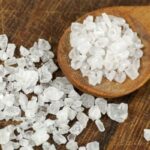We explain what metal oxides are, how they are obtained, they are named and what they are used for. Also, what are non-metallic oxides.

What are metal oxides?
In chemistry, basic oxides or metal oxides are called a type of molecular compounds that result from combining a metal with oxygen. In these compounds the oxygen atom has an oxidation state of -2. Its general formula can be expressed as follows:
x2EITHERn
Where X is the metallic element and n is the valence of said metal.
These compounds are also called basic oxides because react with water forming hydroxides which is why they are also known as bases. These types of compounds are quite common in everyday life since the most abundant chemical elements in the periodic table are, precisely, metallic ones.
Metal oxides retain some of the properties of the metallic element, such as good conductivity of electricity and heat, or their high melting points. Furthermore, they occur in the three states of aggregation of matter.
How are metal oxides obtained?
Metal oxides, as we have said before, are obtained when any metal is reacted with oxygen. We see an example of this when a metal oxidizes due to being in continuous contact with the oxygen present in the air or water. This relationship is usually expressed in the following formula:
Oxygen (O) + Metallic element (X) = Basic or metallic oxide.
Nomenclature of metal oxides
There are different chemical nomenclature systems. To name metal oxides we will use the stoichiometric or systematic system (recommended by the IUPAC) and the STOCK system. There is also a nomenclature system called “traditional”, but it is currently little used.
To name metal oxides according to these systems, some questions must first be taken into account:
- When the metallic element has a single oxidation number (e.g. gallium (Ga) has only 3+):
- Traditional Suffixes and prefixes are added depending on the oxidation state of the metallic elements. For example: gallium oxide (Ga2EITHER3).
- Systematic They are named according to the number of atoms of each type that the molecule has. For example: digallium trioxide (Ga2EITHER3).
- STOCK. The oxidation state of the metal in that compound is added to the end of the name, in Roman numerals and in parentheses. Many times, if the metal has only one oxidation state, the Roman numeral is omitted. For example: gallium (III) oxide or gallium oxide (Ga2EITHER3).
- When the metallic element has two oxidation numbers (for example, lead (Pb) has 2+ and 4+):
- Traditional. Suffixes and prefixes are added depending on the oxidation state of the metallic elements. When the element has the highest oxidation state, the -ico suffix is used and when it has the lowest, the -oso suffix is used. For example: leadic oxide (PbO2) when the oxidation state is the highest (4+) and plumbose oxide (PbO) when the oxidation state is the lowest (2+).
- Systematic The rules are maintained. For example: lead dioxide (PbO2), when it has an oxidation state (4+) and lead monoxide (PbO) when it has an oxidation state (2+).
- STOCK The oxidation state of the metal in that compound is added to the end of the name as appropriate, in Roman numerals and in parentheses. For example: lead(IV) oxide (PbO2) and lead (II) oxide (PbO).
Clarification Sometimes subscripts can be simplified. This is the case of lead (IV) oxide, which could be represented as Pb2EITHER4but the subscripts are simplified and PbO remains2.
- When the metallic element has three oxidation numbers (for example, chromium (Cr) mainly has 2+, 3+, 6+):
- Traditional Suffixes and prefixes are added depending on the oxidation state of the metallic elements. When the element has the highest oxidation state, the suffix -ico is added, for the intermediate oxidation state the suffix -oso is added and for the lowest oxidation state the prefix -hipo is added, followed by the name of the metal, followed by the suffix -oso . For example: chromic oxide (CrO3) when it has an oxidation state (6+), chromium oxide (Cr2EITHER3) when it has an oxidation state (3+) and hypochromic oxide (CrO) when it has an oxidation state (2+).
- Systematic. The rules are maintained. For example: chromium monoxide (CrO) when it has an oxidation state (2+), dichromium trioxide (Cr2EITHER3) when it has oxidation state (3+) and chromium trioxide (CrO3) when it has oxidation state (6+).
- STOCK The oxidation state of the metal in that compound is added to the end of the name as appropriate, in Roman numerals and in parentheses. For example: chromium (II) oxide (CrO), chromium (III) oxide (Cr2EITHER3) and chromium (VI) oxide (CrO3).
- When the element has four oxidation numbers (manganese (Mn) mainly has 2+, 3+, 4+, 7+)
- Traditional When the element has the highest oxidation state, the prefix per- and the suffix -ico are added, for the next oxidation state the suffix -ico is added, for the next oxidation state the suffix -oso is added and for the lowest oxidation state the prefix hypo- and the suffix -oso are added. For example: permanganic oxide (Mn2EITHER7) when it has oxidation state (7+), manganic oxide (MnO2) when it has an oxidation state (4+), manganous oxide (Mn2EITHER3) when it has an oxidation state (3+) and hypomanganose oxide (MnO) when it has an oxidation state (2+).
- Systematic The rules are maintained. For example: dimanganese heptaoxide (Mn2EITHER7) when it has an oxidation state (7+), manganese dioxide (MnO2) when it has the oxidation state (4+), dimanganese trioxide (Mn2EITHER3) when it has an oxidation state (3+) and manganese monoxide (MnO) when it has an oxidation state (2+).
- STOCK The oxidation state of the metal in that compound is added to the end of the name as appropriate, in Roman numerals and in parentheses. For example: manganese (VII) oxide (Mn2EITHER7), manganese(IV) oxide (MnO2), manganese(III) oxide (Mn2EITHER3) and manganese (II) oxide (MnO).
Uses of metal oxides

Metal oxides have a gigantic application in daily life, especially in the manufacture of various chemical substances. Some examples are:
- Magnesium oxide. It is used for the preparation of medicines intended for the stomach, and in the manufacture of antidotes for poisoning.
- Zinc oxide. It is used for the manufacture of paints, dyes and dyeing pigments.
- Aluminum oxide. It is used for extremely hard alloys and other metals for industrial use.
- Lead oxide It is used in the manufacture of glass.
Importance of metal oxides
Metal oxides are extremely important for humans and for contemporary industries, since serve as an additive in many compounds for daily application.
In addition, they are the raw material in chemical laboratories for obtaining bases and other compounds since their abundance makes them much easier to obtain and manipulate.
Examples of metal oxides
Some additional examples of metal oxides are:
- Sodium oxide (Na2EITHER)
- Potassium oxide (K2EITHER)
- Calcium oxide (CaO)
- Cupric oxide (CuO)
- Ferrous oxide (FeO)
- Lead oxide (PbO)
- Aluminum oxide (AlO3)
Non-metallic oxides
non-metallic oxides are those in which oxygen is combined with a non-metallic element, and are known as anhydrides. The most common of these is carbon dioxide (CO2) that we expel in respiration and that plants consume to carry out photosynthesis.
These compounds are very important in biochemistry. Unlike metal ones, are not good conductors of electricity and heat. When they react with water, acids are obtained, also called oxyacids.
Continue with: Metal link
References
- “Basic oxide” on Wikipedia.
- “Basic oxides” in Aula en Red.
- “Chemistry. Formation of metallic and non-metallic oxides and oxygen halides” (video) in Friends of Chemistry.
- “Nomenclature of metal oxides” (video) in Patria Educación.
- “Basic oxides examples” in Natural Sciences.





